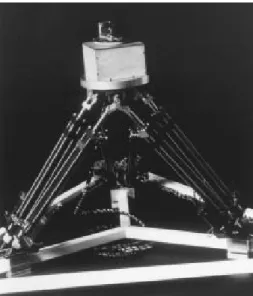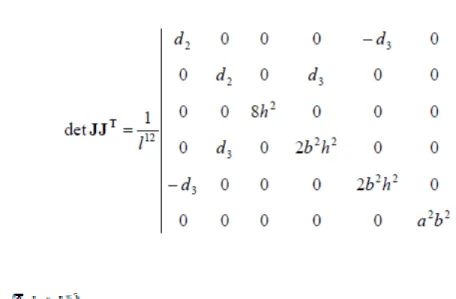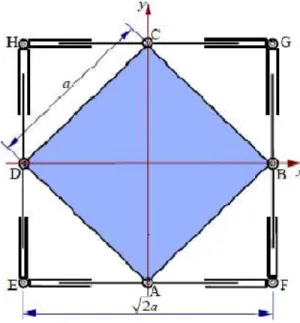Kinematic Analysis and Optimum Design of
8-8 Redundant Spatial In-Parallel Maniputator
P.Chinna Srinivas
M.Tech(CAD/CAM)
Department Of Mechanical Engineering
Jb Institute Of Engineering& Technology,Moinabad(Mdl) Hyderabad -75,India
Y.Dilip kumar, P.Divakara Rao
Associate professor
Department Of Mechanical Engineering
Jb Institute Of Engineering& Technology,Moinabad(Mdl) Hyderabad -75,india
V. sreenivasulu, Dr.C.Udaya Kiran
Associate professor, Professor Department Of Mechanical Engineering
Jb Institute Of Engineering& Technology,Moinabad(Mdl) Hyderabad -75,India
Abstract- The quality index considered will assist the designer to choose the relative dimensions of the fixed and moving platforms, locate joint centers in the fixed and moving platforms, determine an optimum position which would be an ‘ideal’ location of the workspace center, and determine acceptable ranges of pure translations and pure rotations for which the platform is stable Symbolic expressions are derived for the quality indices for different configurations like central symmetric configuration, vertical and horizontal translation of moving platform and rotation of the platform about transverse and vertical axis of symmetry. Jocobin matrice are derived by using ball’s screw theory that is in particular plucker line coordinates. The forward kinematic analysis of the 8-8 redundant in-parallel manipulators to determine the position and orientation of the platform for the given the leg lengths is also studied in the project work. A computer program in matlab 7.0 is written for finding the quality index of the manipulator. Graphs are also plotted by using the same matlab program
KEYWORDS: Manipulators, six-degree-of-freedom, Stewart Platform
I.INTRODUCTION
one actuator controls every limb and all the actuators can be mounted at or near the fixed base. For this reason, parallel manipulators are sometimes called as platform manipulator. Because the actuators can share the external load, parallel manipulators tend to have a large load-carrying capacity[1,15]
II.ADVANTAGES OF PARALLEL MANIPULATORS OVER SERIAL MANIPULATORS
High stiffness
Low inertia
Large payload capacity
However, they suffer the problems of relatively small useful workspace and design difficulties. Furthermore, their direct kinematics is a very difficult problem.
Applications of parallel manipulators: Parallel manipulators can be found in many applications.
Such as in Airplane and automobile simulators
Adjustable articulated trusses
Mining machines
High speed/high-precision milling machines.
Walking machines.
Machine centers
Photonics / Fiber alignment.
2.1 Parallel-Link Robots
By far the most widely used commercial robots are the serial-link manipulators, whose links and joints alternate with one another in an open kinematic chain. This serially connected configuration is similar to that of the human arm, with each link connecting only to two neighboring links through either prismatic or revolute joints, except for the last link which attaches to the end effector and the robot base which attaches to the floor. The advantage of the serial chain structural arrangement is that it provides a large work volume and dexterous manipulability; however, it suffers from a lack of rigidity and from accumulated actuator errors. Especially at high speed and high dynamic loading operating conditions, the serial-link manipulators show poor dynamic performance. To improve the dynamic performance and achieve high precision operations, the robot links must be made with high rigidity, which results in heavy robots with low force-output-to-manipulator-weight ratio. On the other hand, if the links can be arranged parallel to one another in a closed kinematic chain structure such that the major force components add together, then high precision operations and high force-output-to-manipulator-weight ratios can be achieved.[5,18]
Fig: 1 six-degree-of-freedom Stewart platform manipulator : 2 Stewart platform automated surface finishing cell.
2.2 The Stewart Platform
parallel links. The Stewart platform link ends are simply supported, making the manipulator system far more rigid in proportion to size and weight than any serial link robot. Furthermore, the links of the Stewart platform are arranged so that the major force components of the six actuators add together, yielding a force-output-to-manipulator-weight ratio more than one order of magnitude greater than most industrial robots. The original Stewart platform was designed for an aircraft simulator and consisted of six linear hydraulic actuators acting in parallel between the base and the upper platform. All the links are connected both at the base and at the upper platform. Thus, by changing the length of each link, the position and orientation of the upper platform are able to be controlled manipulator
III.QUALITY INDEX OF 8-8 IN-PARALLEL ROBOT MANIPULATOR
Fig: 5.1 Redundant 8-8 in-parallel
Fig: 5.2 Plan view of the redundant 8-8 in-parallel manipulator
5.1 Quality index for central symmetrical configuration
Firstly, the coordinates of the points A, B, C, and D on the platform and E, F, G, and H on the base are determined with the origin of a fixed coordinate system placed at the center of the square base, and
Then, using the Grassmann method to calculate the Plücker line coordinates of the eight leg lines, i.e., counting the 2×2 determinants of the various arrays of the joins of the pairs of points EA, FA, FB, GB, GC, HC, HD, and ED. For example, the coordinates of the line $1 are obtained using the coordinates of points E and A in to form the array
Where
Where
The variation of the quality index now is investigated for a number of simple motions of the top platform. Here, an optimal redundant 8-8 parallel manipulator with platform side a = 1, and thus base side b = is taken as an example.[4,16]
5.2 Quality index for vertical translation of the moving platform
First, consider a pure vertical translation of the platform from the central symmetric position along the z-axis while remaining parallel to the base. For such movement, , the quality index is given by
Height h Quality index λ
0.01 0.00
0.26 0.20
0.38 0.40
0.42 0.60
0.49 0.80
0.72 1.00
1.0 0.85
1.1 0.8
1.35 0.6
1.5 0.44
1.6 0.4
2.0 0.25
2.2 0.2
2.5 0.17
3 0.11
Fig: 5.4 Quality index for platform vertical movement
Fig: 5.5 plan view of the optimal configuration of the redundant 8-8 in-parallel manipulator with the maximum quality index
It shows that at height the quality index of the redundant 8-8 parallel manipulator has a maximum value, λ =1.
5.3 Quality index for horizontal translation of moving platform
Assume the center of the moving platform to move to point (x, y, h), then the coordinates of the points A, B, C, and
D on the platform become
The coordinates of points E, F, G, and H on the base can be found from (5.1). Thus, the Plücker line coordinates for
each of the eight leg lines can be determined as
, (5.30)
, (5.31)
, (5.32)
, (5.33)
, (5.34)
, (5.35)
, (5.36)
, (5.37)
The above coordinates are not normalized and each row must be divided by the corresponding leg length. The Jacobian matrix J then can be constructed by using (5.11). Further, substituting and expanding yields
(5.38)
where the leg lengths are
(5.39)
Fig 5.7 shows the contours of the quality index for this platform horizontal movement. The contours are labeled with values of constant quality index and they are close to being concentric circles of various radii. When x or y is infinite, λ =0, and when x=y=0, λ =1.
Fig. 5.6 Quality index for platform horizontal translation
Fig.5.7 The Contour plot of Quality Index for platform horizontal translation
V.CONCLUSIONS
The quality index for redundant parallel manipulators has been defined as a dimensionless ratio which takes a maximum value of 1 at a central symmetrical configuration that is shown to correspond to the maximum value of the square root of the determinant of the product of the manipulator Jacobian by its transpose. A quality index has two clear meanings so far. When λ =0, a platform is in singular condition and when λ =1, it is in its optimal geometry static configuration. However, when λ is neither zero nor one, it is hard to say exactly how much one configuration is better than another. One can not say that a configuration with λ =0.8 is twice as good as a configuration with λ =0.4 without further analyses. However, a quality index helps in the design platforms by setting dimensions that give best quality index value. Also, it gives an idea of certain designs that must be prevented as they would lead to zero or lower quality indexes. The quality index reflects singularities, and therefore gives an indication of the safe regions within which the manipulator can be maneuvered and controlled. Using quality index, variable motions are investigated for which a moving Platform rotates about a central axis or moves parallel to the base. It shows that the wider the range of high quality index, the better the design of a parallel manipulator. Thus, the quality index can be used as a constructive measure not only of an acceptable operating workspace but also of acceptable and optimum design proportions. Additionally, the redundant 8-8 parallel manipulator contains double-spherical joints. There are eight of them and they are the source of critical practical difficulties since they can produce serious mechanical interference. There appears to be no reasonable alternative than to accept a reduction in the maximum quality index through separation by fairly short distances of some or all of the double-spherical joints Redundant in-parallel manipulators present many interests in various applications: increase dexterity, reduce or even eliminate singularities, increase reliability, simplify the forward kinematics, and improve load distribution in actuators.
REFERENCES
[1] Merlet, J. P., “Parallel robots,”
[3] Buttolo, P., and Hannaford, B., “Advantages of Actuation Redundancy for theDesign of Haptic Displays,” Proceedings of ASME Fourth
Annual Symposium onHaptic Interfaces for Virtual Environment and Teleoperator Systems, Vol. DSC57-2, pp. 623-630, San Francisco,
November 1995.
[4] Buttolo, P., and Hannaford, B., “Pen-Based Force Display for Precision Manipulation in Virtual Environments,” Proceedings of IEEE
Virtual Reality Annual International Symposium, pp. 217-225, Raleigh, North Carolina, March 1995.
[5] Kock, S., and Schumacher, W., “A Parallel X-y Manipulator with Actuation Redundancy for High Speed and Active Stiffness Applications,” IEEE Int. Conf. on Robotics and Automation, pp. 2295-2300, Louvain, 1998.
[6] Notash, L., and Podhorodeski, R. P., “Forward Displacement Analysis and Uncertainty Configurations of Parallel Manipulators with a Redundant Branch,”Journal of Robotic Systems, Vol. 13, No. 9, pp. 587-601, 1996.
[7] Maeda, K., Tadokoro, S., Takamori, T., Hiller, M., and Verhoeven, R., “On Design of a Redundant Wire-Driven Parallel Robot WARP Manipulator,” IEEE Int. Conf.on Robotics and Automation, pp. 895-900, Detroit, May 1999.
[8] O’Brien, J. F., and Wen, J. T., “Redundant Actuation for Improving Kinematic Manipulability,” IEEE Int. Conf. on Robotics and
Automation, pp. 1520-1525,Detroit, May 1999.Leguay-Durand, S., and Reboulet, C., “Optimal Design of a Redundant Spherical Parallel
Manipulator,” Robotica, Vol. 15, No. 4, pp. 399-405, 1997.
[9] Kurtz, R., and Hayward, V., “Multiple-Goal Kinematic Optimization of a Parallel Spherical Mechanism with Actuator Redundancy,” IEEE
Transactions on Robotics and Automation, Vol. 8, No. 5, pp. 644-651, October 1992.
[10] Kokkinis, T., and Millies, P., “A Parallel Robot-Arm Regional Structure with Actuational Redundancy,” Mechanism and Machine Theory, Vol. 26, No. 6, pp. 629-641, 1991.
[11] Nakamura, Y., and Ghodoussi, M., “Dynamics Computation of Closed-Link RobotMechanisms with Nonredundant and Redundant Actuators,” IEEE Transactions onRobotics and Automation, Vol. 5, No. 3, pp. 294-302, June 1989.
[12] Dasgupta, B., and Mruthyunjaya, T. S., “Force Redundancy in Parallel Manipulators:Theoretical and Practical Issues,” Mechanism and
Machine Theory, Vol. 33, No. 6,pp. 727-742, 1998.
[13] Dasgupta, B., and Mruthyunjaya, T. S., “The Stewart Platform Manipulator: A Review,” Mechanism and Machine Theory, Vol. 35, No. 1, pp. 15-40, 2000.
[14] Perng, M., and Hsiao, L., “Inverse Kinematic Solutions for a Fully Parallel Robotwith Singularity Robustness,” The International Journal
of Robotics Research, Vol.18, No. 6, pp. 575-583, June 1999.
[15] Ashitava Ghosal and Bahram Ravani. “A Differential-Geometric Analysis of Singularities of Point Trajectories of Serial and Parallel Manipulators,” ASME Journal of Mechanical Design, Vol. 123, pp 80-89, March 2001.
[16] Guilin Yang et al. “A Geometrical Method for the Singularity Analysis of 3-RRR Planar Parallel Robots with Different Actuation Schemes,” IEEE, proc. Int. Conf. on Intelligent Robots and Systems, pp 2055-2060, October 2002.
[17] Xianwen Kong and Clement M. Gosselin. “Kinematics and Singularity Analysis of a Novel Type of 3-CRR 3-dof Translational Parallel Manipulator,” The International Journal of Robotics Research Vol. 21, No. 9, pp 791-798, Sep 2002.
[18] Han Sung Kim and Lung-Wen Tsai. “Design Optimization of a Cartesian Parallel Manipulator,” ASME the Journal of Mechanical Design, Vol. 125, pp 43-56, March 2003.




